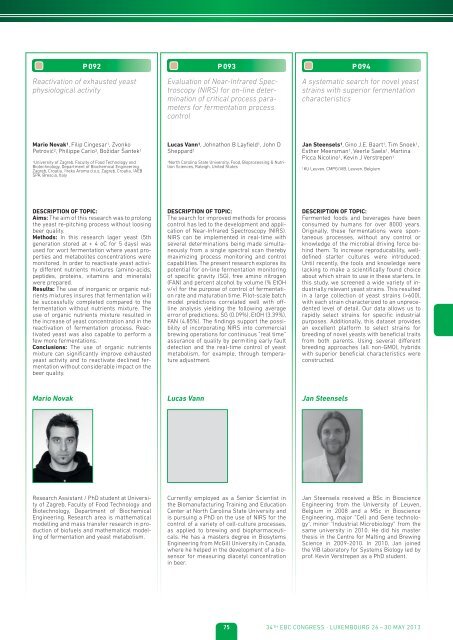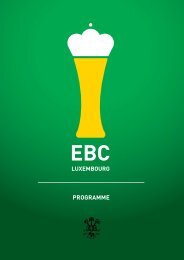please click here for download. - the 34th European Brewery ...
please click here for download. - the 34th European Brewery ...
please click here for download. - the 34th European Brewery ...
You also want an ePaper? Increase the reach of your titles
YUMPU automatically turns print PDFs into web optimized ePapers that Google loves.
P 092<br />
Reactivation of exhausted yeast<br />
physiological activity<br />
P 093<br />
Evaluation of Near-Infrared Spectroscopy<br />
(NIRS) <strong>for</strong> on-line determination<br />
of critical process parameters<br />
<strong>for</strong> fermentation process<br />
control<br />
P 094<br />
A systematic search <strong>for</strong> novel yeast<br />
strains with superior fermentation<br />
characteristics<br />
Mario Novak 1 , Filip Cingesar 1 , Zvonko<br />
Petrović 2 , Philippe Cario 3 , Božidar Šantek 1<br />
1University of Zagreb, Faculty of Food Technology and<br />
Biotechnology, Department of Biochemical Engineering,<br />
Zagreb, Croatia, 2 Ireks Aroma d.o.o, Zagreb, Croatia, 3 AEB<br />
SPA, Brescia, Italy<br />
Lucas Vann 1 , Johnathon B Layfield 1 , John D<br />
Sheppard 1<br />
1North Carolina State University, Food, Bioprocessing & Nutrition<br />
Sciences, Raleigh, United States<br />
Jan Steensels 1 , Gino J.E. Baart 1 , Tim Snoek 1 ,<br />
Es<strong>the</strong>r Meersman 1 , Veerle Saels 1 , Martina<br />
Picca Nicolino 1 , Kevin J Verstrepen 1<br />
1KU Leuven, CMPG/VIB, Leuven, Belgium<br />
DESCRIPTION OF TOPIC:<br />
Aims: The aim of this research was to prolong<br />
<strong>the</strong> yeast re-pitching process without loosing<br />
beer quality.<br />
Methods: In this research lager yeast (5th<br />
generation stored at + 4 oC <strong>for</strong> 5 days) was<br />
used <strong>for</strong> wort fermentation w<strong>here</strong> yeast properties<br />
and metabolites concentrations were<br />
monitored. In order to reactivate yeast activity<br />
different nutrients mixtures (amino-acids,<br />
peptides, proteins, vitamins and minerals)<br />
were prepared.<br />
Results: The use of inorganic or organic nutrients<br />
mixtures insures that fermentation will<br />
be successfully completed compared to <strong>the</strong><br />
fermentation without nutrients mixture. The<br />
use of organic nutrients mixture resulted in<br />
<strong>the</strong> increase of yeast concentration and in <strong>the</strong><br />
reactivation of fermentation process. Reactivated<br />
yeast was also capable to per<strong>for</strong>m a<br />
few more fermentations.<br />
Conclusions: The use of organic nutrients<br />
mixture can significantly improve exhausted<br />
yeast activity and to reactivate declined fermentation<br />
without considerable impact on <strong>the</strong><br />
beer quality.<br />
DESCRIPTION OF TOPIC:<br />
The search <strong>for</strong> improved methods <strong>for</strong> process<br />
control has led to <strong>the</strong> development and application<br />
of Near-Infrared Spectroscopy (NIRS).<br />
NIRS can be implemented in real-time with<br />
several determinations being made simultaneously<br />
from a single spectral scan t<strong>here</strong>by<br />
maximizing process monitoring and control<br />
capabilities. The present research explores its<br />
potential <strong>for</strong> on-line fermentation monitoring<br />
of specific gravity (SG), free amino nitrogen<br />
(FAN) and percent alcohol by volume (% EtOH<br />
v/v) <strong>for</strong> <strong>the</strong> purpose of control of fermentation<br />
rate and maturation time. Pilot-scale batch<br />
model predictions correlated well with offline<br />
analysis yielding <strong>the</strong> following average<br />
error of predictions: SG (0.09%), EtOH (3.39%),<br />
FAN (4.85%). The findings support <strong>the</strong> possibility<br />
of incorporating NIRS into commercial<br />
brewing operations <strong>for</strong> continuous “real time”<br />
assurance of quality by permiting early fault<br />
detection and <strong>the</strong> real-time control of yeast<br />
metabolism, <strong>for</strong> example, through temperature<br />
adjustment.<br />
DESCRIPTION OF TOPIC:<br />
Fermented foods and beverages have been<br />
consumed by humans <strong>for</strong> over 8000 years.<br />
Originally, <strong>the</strong>se fermentations were spontaneous<br />
processes, without any control or<br />
knowledge of <strong>the</strong> microbial driving <strong>for</strong>ce behind<br />
<strong>the</strong>m. To increase reproducability, welldefined<br />
starter cultures were introduced.<br />
Until recently, <strong>the</strong> tools and knowledge were<br />
lacking to make a scientifically found choice<br />
about which strain to use in <strong>the</strong>se starters. In<br />
this study, we screened a wide variety of industrially<br />
relevant yeast strains. This resulted<br />
in a large collection of yeast strains (>600),<br />
with each strain characterized to an unprecedented<br />
level of detail. Our data allows us to<br />
rapidly select strains <strong>for</strong> specific industrial<br />
purposes. Additionally, this dataset provides<br />
an excellent plat<strong>for</strong>m to select strains <strong>for</strong><br />
breeding of novel yeasts with beneficial traits<br />
from both parents. Using several different<br />
breeding approaches (all non-GMO), hybrids<br />
with superior beneficial characteristics were<br />
constructed.<br />
Mario Novak<br />
Lucas Vann<br />
Jan Steensels<br />
Research Assistant / PhD student at University<br />
of Zagreb, Faculty of Food Technology and<br />
Biotechnology, Department of Biochemical<br />
Engineering. Research area is ma<strong>the</strong>matical<br />
modelling and mass transfer research in production<br />
of biofuels and ma<strong>the</strong>matical modelling<br />
of fermentation and yeast metabolism.<br />
Currently employed as a Senior Scientist in<br />
<strong>the</strong> Biomanufacturing Training and Education<br />
Center at North Carolina State University and<br />
is pursuing a PhD on <strong>the</strong> use of NIRS <strong>for</strong> <strong>the</strong><br />
control of a variety of cell-culture processes,<br />
as applied to brewing and biopharmaceuticals.<br />
He has a masters degree in Biosytems<br />
Engineering from McGill University in Canada,<br />
w<strong>here</strong> he helped in <strong>the</strong> development of a biosensor<br />
<strong>for</strong> measuring diacetyl concentration<br />
in beer.<br />
Jan Steensels received a BSc in Bioscience<br />
Engineering from <strong>the</strong> University of Leuven,<br />
Belgium in 2008 and a MSc in Bioscience<br />
Engineering, major “Cell and Gene technology“,<br />
minor “Industrial Microbiology“ from <strong>the</strong><br />
same university in 2010. He did his master<br />
<strong>the</strong>sis in <strong>the</strong> Centre <strong>for</strong> Malting and Brewing<br />
Science in 2009-2010. In 2010, Jan joined<br />
<strong>the</strong> VIB laboratory <strong>for</strong> Systems Biology led by<br />
prof. Kevin Verstrepen as a PhD student.<br />
75 34 TH EBC CONGRESS · LUXEMBOURG 26 – 30 MAY 2013





